Parliament Hill
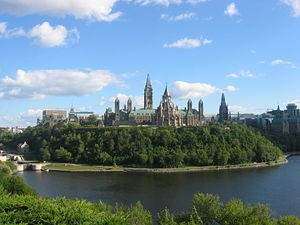
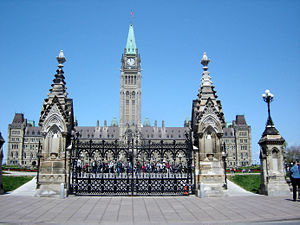
Parliament Hill (colloquially The Hill, French Colline du Parlement) is a scenic location on the southern banks of the Ottawa River in downtown Ottawa, Ontario. Its Gothic revival suite of buildings – the Parliament Buildings – serves as the home of the Parliament of Canada; the best known of these buildings is the Centre Block, with its prominent Peace Tower, a national symbol. Parliament Hill attracts approximately 3 million visitors each year.[1]
Contents |
History
Parliament Hill is a limestone outcrop with a gently sloping top. For hundreds of years it served as a landmark on the Ottawa River for First Nations, and later European traders, adventurers and industrialists, to mark their journey to the interior of the continent. After Ottawa, then called Bytown, was founded, the builders of the Rideau Canal used the hill as a location for a military base, naming it Barrack Hill. A large fortress was planned for the site, but was never built, and by 1858 it had lost its strategic importance.
In that same year, Queen Victoria selected Bytown as the capital of the Province of Canada. Barrack Hill was chosen as the site for the new parliament buildings, given its prominence over both the town and the river, as well as the fact that it was already owned by the Crown. Within less than two years, on December 20, 1859, ground was broken on the site; by summer of the following year, Prince Albert Edward, Prince of Wales, laid the cornerstone of the new parliament. It became the largest project undertaken in North America to that date. The complex was not completed, however, when three colonies of British North America confederated, with the potential for others to join as provinces, with Ottawa remaining the capital. Thus, the bureaucracy of parliament spread to buildings beyond Parliament Hill even at that early date.[2]
By 1876 the structures of Parliament Hill were completed, along with the wrought iron fence and Queen's Gates, forged by Ives & Co. of Montreal. However, the grounds had yet to be properly designed; Governor General Lord Dufferin sent chief architect Thomas Scott to New York City to meet with Calvert Vaux and view Central Park. Vaux completed a layout for the landscape, including the present day driveways, terraces, and main lawn; Scott created more informal grounds to the sides of and behind the parliament.[2]
The Centre Block was destroyed by fire on February 3, 1916. Despite the ongoing war, the original cornerstone was re-laid by Governor General Prince Arthur, Duke of Connaught, on September 1, 1916; exactly fifty-six years after his brother, by now the late King Edward VII, had first set it. Eleven years later the new tower was completed, dedicated as the Peace Tower in commemoration of the Canadians who had lost their lives during the First World War.
Parliament buildings
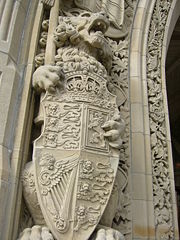
The entire parliamentary precinct measures 112,360 square metres (1,209,433 sq ft), bounded on the north by the Ottawa River, on the east by the Rideau Canal, on the south by Wellington Street, and on the west by a service road near the Supreme Court.
The main buildings are: the Centre Block, built between 1865 and 1927, containing the House of Commons and Senate chambers, and featuring the Peace Tower and Library of Parliament; the East Block, built in two stages in 1867 and 1910, containing senators' offices and preserved Confederation-era rooms; and the West Block, built in 1865, containing ministers' and MPs' offices and meeting rooms. The three blocks are disposed around a large grassy quadrangle, while the Centre Block is surrounded by lawns and a walk overlooking the Ottawa River. The Library of Parliament was opened in 1876. The Legislature of the Province of Canada met for the first time in the new building on June 8, 1866, and the new Parliament of the Dominion of Canada began its first session there on November 6, 1867.
The overall site is in a combination of the High Victorian Gothic, English garden, formal garden styles popular at the end of the 19th century. The Palace of Westminster and precinct had recently been rebuilt in a similar style, and the choice of a gothic rather than an American inspired neoclassical design, was a symbol of Canada's continued links to Britain.
The only structure on Parliament Hill to have been purposefully demolished was the building, which had been behind the West Block, that housed the Supreme Court between 1889 and 1945. Throughout the 1950s and 1960s there were discussions to tear down other parliamentary precinct buildings, including the Library of Parliament and West Block for new structures, and the East Block for parking. None of these plans were carried out.[3]
Plans
Since 2002 a thorough renovation project has been going on across the parliamentary precinct, specifically focusing on West Block renovations, security of perimeters, pedestrian and vehicle screening, circulation of traffic/delivery and parking.[4] Increased costs due to greater deterioration of the heritage buildings. Significant increase in building commodities (steel) and labour costs (highly specialized and skilled trades) Increased allowances for risks based on experience with other heritage rehabilitation projects such as the Library of Parliament. In 2012, the Centre Block is scheduled to be closed for five years for an extensive interior renovation. In preparation, the other buildings are being renovated and expanded first; the inner courtyards of the West and East Blocks will be enclosed, and temporary chambers for the House of Commons and Senate installed. Public Works estimates that the total price for renovations, not including the Centre Block, will be more than $1 billion.[5]
Major events
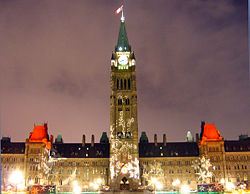
Parliament Hill is the site of annual Canada Day celebrations, presided over by the Governor General and his or her Prime Minister. Canada's monarch, Queen Elizabeth II, has also been present at these festivities in 1990, 1992, and 1997, and earlier presided over the Canadian Centennial celebrations on July 1, 1967, on The Hill.
Another annual event, during the summer months, is the Changing of the Guard on the centre lawn.
Among the major events Parliament Hill has hosted:
- Celebration of Queen Victoria's birthday in 1865
- Memorial for the death of Queen Victoria
- The first visit of Canada's reigning monarch, King George VI, with his consort Queen Elizabeth, on May 19, 1939
- The raising of Canada's new national flag for the first time on February 15, 1965
- The lighting of the Centennial Flame on December 31, 1966
- The celebration of Queen Elizabeth II's Silver Jubilee on October 18, 1977
- The proclamation of the Constitution Act by Queen Elizabeth II on April 17, 1982
- Celebrations for the Millennium
- The memorial service for the victims of the September 11, 2001 attacks in 2001, attended by 100,000 people, and called "the largest single vigil" ever seen in the nation's capital[6]
- The celebration of Queen Elizabeth II's Golden Jubilee on October 13, 2002
- Canadians lying in state. Among them:
- former Governors General:
- John Buchan, 1st Baron Tweedsmuir
- Georges Vanier
- Ray Hnatyshyn
- former Prime Ministers:
- The Unknown Soldier
- former Governors General:
Statues and monuments
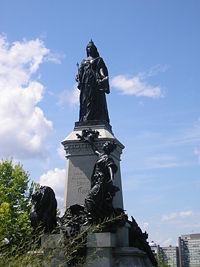
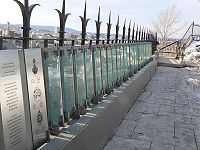
Numerous statues and monuments are arranged across Parliament Hill, mostly on the grounds behind the three blocks. The following is a list of the statues and monuments, in order of their date completed, or, if the date is unknown, in alphabetical order:
- Queen Victoria - located north of the West Block; sculpted by Louis-Philippe Hébert (1900)
- Alexander Mackenzie - located west of the Centre Block; sculpted by Louis-Philippe Hébert (1901)
- Henry Albert Harper / Galahad - located outside the Queen's Gates, facing Centre Block; sculpted by Ernest Wise Keyser (1905)
- George Brown - located west of the Centre Block; sculpted by George William Hill (1913)
- Robert Baldwin and Sir Louis-Hippolyte Lafontaine - located east of the Centre Block; sculpted by Walter Seymour Allward (1914)
- Sir Wilfrid Laurier - located south of the East Block; sculpted by Joseph-Émile Brunet (1922)
- Sir Robert Laird Borden - located west of the West Block; sculpted by Frances Loring (1957)
- Queen Elizabeth II - located east of the Centre Block; sculpted by Jack Harman (1977)
- John George Diefenbaker - located north of the West Block; sculpted by Leo Mol (1985)
- Lester Bowles Pearson - located north of the West Block; sculpted by Danek Mozdzenski (1989)
- Sir George-Étienne Cartier - located west of the Centre Block; sculpted by Louis-Philippe Hébert
- The Famous Five - depicts the women's suffrage movement (Nellie McClung, Irene Parlby, Emily Murphy, Louise McKinney and Henrietta Muir Edwards); sculpted by Barbara Paterson; the monument is featured on the reverse of the current $50 banknote
- Sir John A. Macdonald - located east of the Centre Block; sculpted by Louis-Philippe Hébert
- William Lyon Mackenzie King - located north of the East Block; sculpted by Raoul Hunter
- Thomas D'Arcy McGee - located north of the Centre Block; sculpted by George William Hill
- Other memorials on Parliament Hill include
- Centennial Flame - located in front of the Centre Block; commemorates the Centennial of Canada (1967)
- Canadian Police Memorium - located north of the Centre Block (1995)
- Victoria Tower Bell (1875-1877) - located north of the Centre Block; original bell of the first Centre Block tower (2000)
| Library of Parliament Centre Block Commons | Senate Peace Tower |
||
| West Block | Parliament of Canada Parliament Hill |
East Block |
See also
- Parliamentary cats - located to the rear woods north of Parliament Hill
- Government Hill, Hong Kong
- Parliament Hill, London
- Queen's Park (Toronto)
- Parliamentary Press Gallery
References
- ↑ Canadian Press; CTV News: Parliament Hill tourist facilities overwhelmed; May 6, 2007
- ↑ 2.0 2.1 Government of Canada: Construction, 1859-1916
- ↑ Government of Canada: Reconstruction, 1916-1965
- ↑ Government of Canada: A Legacy for Future Generations
- ↑ CTV.ca | Renovations for Parliament buildings pass $1 billion
- ↑ CNN LATE EDITION WITH WOLF BLITZER, Interview With Paul Martin
- ↑ Trudeau: 1919-2000
External links
- Official site
- Canada by Design: Parliament Hill, Ottawa at Library and Archives Canada
- Webcam pointed at Centre Block
- Peace Tower
|
|||||||||||||||||||||||||||||
